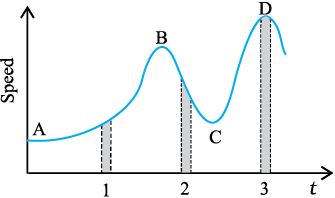3.22 Figure 3.25 gives a speed-time graph of a particle in motion along a constant direction. Three equal intervals of time are shown. In which interval is the average acceleration greatest in magnitude? In which interval is the average speed greatest? Choosing the positive direction as the constant direction of motion, give the signs of v and a in the three intervals. What are the accelerations at points A, B, C, and D?

Fig. 3.25
i) As the change of speed is greatest in interval 2, So the magnitude of acceleration is greatest in interval 2
ii) Height of the curve from the time-axis gives the average speed of the particle. It is apparent from the graph that height is the greatest in interval 3. Hence, the average speed of the particle is the greatest in interval 3.
iii) v is positive in all the intervals
Acceleration is positive in interval 1 and 3 as speed is increasing while it is negative in interval 2 as speed is decreasing
iv) Points A, B, C, and D are all parallel to the time-axis. Hence, the slope is zero at these points. Therefore, at points A, B, C, and D, the acceleration of the particle is zero.

© 2026 GoodEd Technologies Pvt. Ltd.